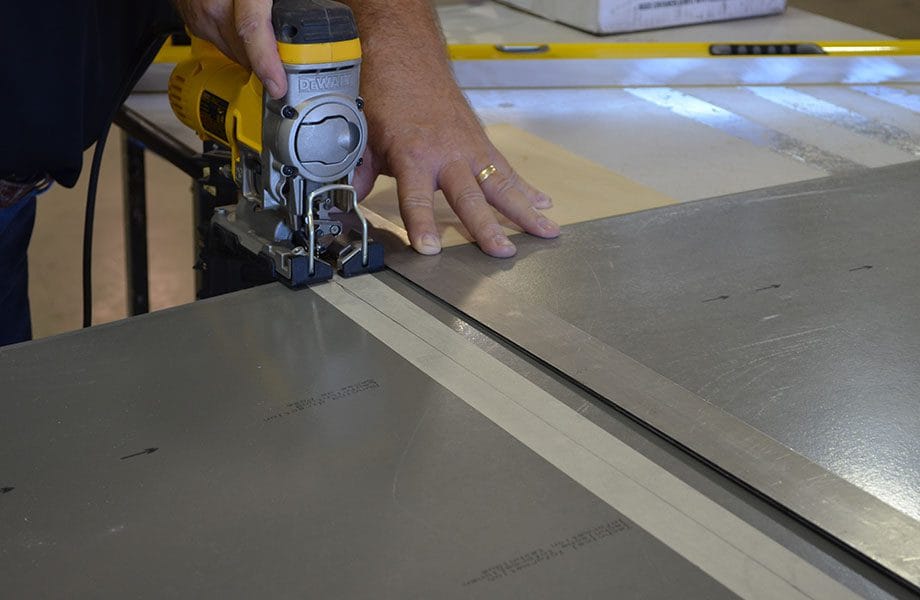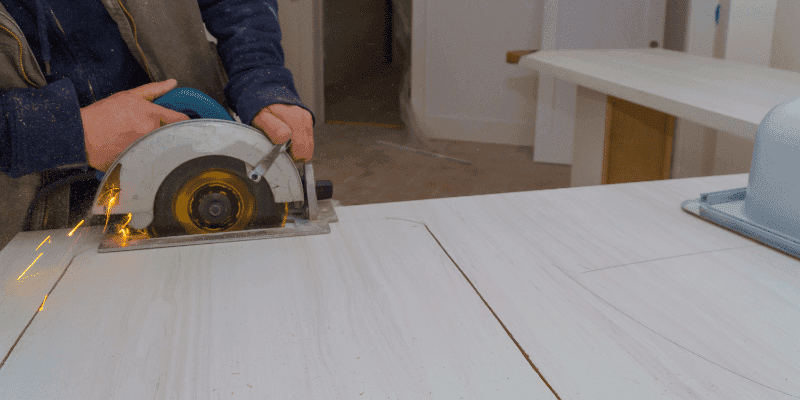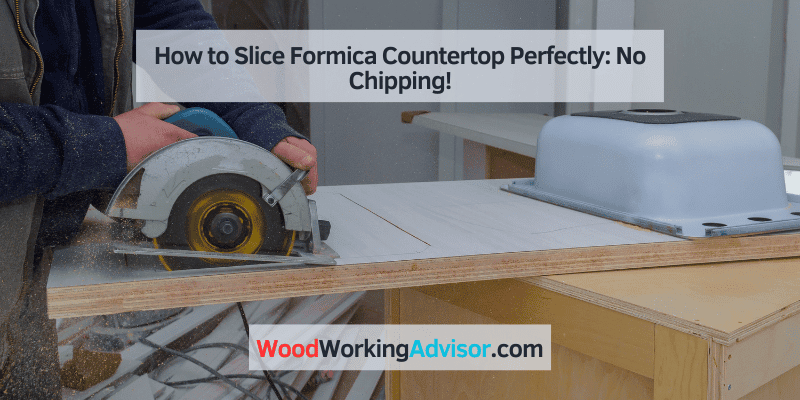To cut a Formica countertop without chipping, use a circular saw equipped with a fine-toothed blade and apply masking tape along the cutting line. Are you planning to cut a Formica countertop without worrying about chipping?
You’ve come to the right place! Cutting Formica can be a delicate process, but with the right tools and techniques, you can achieve a clean cut without any chips. In this guide, we will show you how to cut a Formica countertop using a circular saw and provide you with some valuable tips to ensure a smooth and professional result.
So, let’s dive in and learn how to achieve a chip-free cut on your Formica countertop!
Understanding The Potential Challenges
Discover practical strategies for cutting a Formica countertop without chipping. Gain valuable insights into the potential challenges and find effective solutions to achieve a flawless result.
When it comes to cutting Formica countertops without chipping, it’s essential to be aware of the potential challenges you may face. By understanding these challenges, you can take the necessary precautions to achieve a clean cut. In this section, we will explore why Formica countertops may chip during the slicing process and the factors that contribute to this issue.
Why Formica Countertops May Chip During The Slicing Process:
- Pressure: Applying excessive pressure while cutting the Formica countertop can lead to chipping. This is especially true if the countertop is old or poorly installed.
- Blade selection: Using the wrong blade can significantly increase the risk of chipping. A blade with a large tooth count is more suitable for cutting Formica countertops, as it reduces the chance of chipping.
- Technique: Improper cutting technique can also result in chipping. It’s crucial to use slow and steady movements while cutting and avoid rushing the process to maintain control over the cut.
Factors That Contribute To Chipping:
- The condition of the countertop: Older or poorly installed Formica countertops may have weakened edges, making them more prone to chipping during the cutting process.
- Material hardness: Some Formica countertops may be more prone to chipping due to variations in material hardness. Different types of Formica may have different levels of durability, impacting their resistance to chipping.
- Cutting tools: Low-quality or dull cutting tools can increase the likelihood of chipping when working with Formica countertops. It’s important to ensure that you have sharp and appropriate tools for the task.
Understanding these factors is crucial in preventing chipping during the cutting process. By focusing on the pressure applied, selecting the right blade, and honing the correct technique, you can minimize the risks associated with cutting Formica countertops.
Potential Consequences Of Chipped Formica Countertops:
- Aesthetics: Chipped Formica countertops can significantly affect the overall appearance of your kitchen or workspace. The exposed edges and damaged surface may create an unattractive and unfinished look.
- Hygiene concerns: Chipped edges can pose hygiene concerns as they may accumulate dirt, moisture, and bacteria. This can lead to potential health hazards, especially in a kitchen environment where food is prepared.
- Maintenance issues: Chipped Formica countertops may require immediate repairs or replacement, which can be time-consuming and costly. Ignoring the chipped area can also cause further damage, requiring extensive repairs in the future.
To maintain the beauty, hygiene, and functionality of your Formica countertops, it’s crucial to take precautions and employ the right techniques while cutting. By minimizing the potential for chipping, you can ensure a pristine and long-lasting surface that enhances the overall appeal of your space.
Preparing For The Slicing Process
Learn the key strategies of preparing for the slicing process to avoid chipping your Formica countertop. Discover how to cut with precision while maintaining the integrity of the surface.
Gathering The Necessary Tools
To successfully cut a Formica countertop without chipping, you will need a few essential tools. Here’s what you’ll need:
- Circular saw with a fine-tooth blade: This type of blade is ideal for cutting Formica countertops as it provides clean and precise cuts without causing any chipping.
- Clamp: A clamp will help secure the countertop in place and prevent any movement during the cutting process, ensuring a smooth cut.
- Measuring tape: Accurate measurements are crucial to ensure that the countertop is cut to the desired size. A measuring tape will help you get precise measurements.
- Masking tape: This tape can be used to mark the cutting line on the countertop, providing a guide for the circular saw.
Now that you have gathered all the necessary tools, let’s move on to the next step.
Slicing Techniques To Prevent Chipping
Learn effective slicing techniques to prevent chipping when cutting Formica countertops. These methods ensure a clean and flawless cut, preserving the integrity of the surface for a professional finish.
To ensure a smooth and chip-free cutting experience when working with Formica countertops, it’s important to employ the right slicing techniques. By following these methods, you can achieve clean and precise cuts without damaging the surface material. Below are some techniques to consider:
Choosing The Appropriate Blade For Formica Countertops:
- Use a fine-toothed saw blade specifically designed for cutting laminate materials.
- Opt for a carbide-tipped blade to ensure longevity and precision.
- A blade with a high tooth count (around 40 to 60 teeth) will provide smoother cuts.
Using Masking Tape To Minimize Chipping:
- Apply a strip of masking tape along the cutting line on the top surface of the Formica.
- This helps to reduce splintering and chipping by providing extra support and stability during the cutting process.
Applying The Correct Amount Of Pressure:
- Apply a consistent and controlled amount of pressure while cutting.
- Avoid excessive force, as it can cause the blade to catch or chip the material.
- Let the saw do the work, gently guiding it along the intended cutting path.
Employing Proper Cutting Techniques:
- Start by marking the cutting line using a pencil or masking tape as a guide.
- Begin the cut with a slow and steady motion, ensuring the blade makes contact with the Formica evenly.
- Maintain a steady pace to prevent the blade from getting caught or causing chipping.
- To minimize tear-out, support the laminate from underneath with a sacrificial board.
Taking Breaks To Prevent Overheating:
- If you notice the blade or the Formica countertop getting too hot, take a break to prevent overheating.
- Overheating can cause the laminate to warp or melt, leading to chips and rough edges.
- Allow the saw blade and material to cool down before proceeding with the cutting process.
By employing these slicing techniques, you can cut Formica countertops with precision and minimize the risk of chipping. Remember to choose the appropriate blade, utilize masking tape for added support, apply the correct amount of pressure, use proper cutting techniques, and take breaks to prevent overheating.
With these practices in place, you’ll be able to achieve clean and chip-free cuts for a flawless finish.

Finishing And Post-Slicing Steps
Learn how to cut a Formica countertop without chipping by following the necessary finishing and post-slicing steps. This ensures a clean, precise cut for your countertops.
Formica countertops offer a durable and stylish surface for your kitchen, but cutting them without chipping can be tricky. In this section, we will discuss the finishing and post-slicing steps that can help you achieve a chip-free result. By following these steps, you can ensure a smooth and professional-looking edge for your Formica countertop.
Controlling Dust And Debris:
- Before starting the finishing process, make sure to clean the area thoroughly to remove any dust or debris. This will help prevent them from getting trapped between the Formica and the cutting tool.
- Use a vacuum cleaner or a damp cloth to clean the countertop surface, ensuring that it is free from any particles that could cause chipping during the finishing process.
- Wearing a dust mask and safety goggles is essential to protect yourself from inhaling dust and debris.
Cleaning The Countertop Surface:
- After cutting the Formica countertop, clean any residue left behind using a soft brush or cloth. This will prevent debris from interfering with the bonding of the edge banding and the countertop surface.
- Use a mild dish soap or a countertop cleaner to remove any stubborn stains or adhesive residue. Gently scrub the surface with a soft cloth or sponge.
- Rinse the countertop thoroughly with clean water and dry it to ensure a clean and smooth surface for the next step.
Avoiding Common Mistakes During Finishing:
- One common mistake is using too much pressure while sanding the countertop. Apply light to moderate pressure to avoid damaging the Formica surface.
- Always work in small sections and use a back-and-forth or circular motion while sanding to ensure even and smooth results. Avoid sanding in one direction continuously as it can create uneven edges and increase the risk of chipping.
- Keep the sanding block or sandpaper clean and change it regularly to maintain its effectiveness.
- Take breaks during the sanding process to prevent overheating the surface.
Applying Edge Banding:
- Measure the length and width of the countertop edge and cut the edge banding material accordingly. Ensure that the edge banding is slightly longer than the edge to allow for trimming.
- Apply a thin layer of adhesive to both the edge banding and the countertop edge. Use a small brush or a roller to spread the adhesive evenly.
- Carefully align the edge banding with the countertop edge, ensuring that it overlaps slightly on the top surface.
- Use a laminate roller or a block of wood wrapped in a cloth to press the edge banding firmly, making sure there are no air bubbles or gaps.
- Trim the excess edge banding using a utility knife, following the contour of the countertop edge. Use a file or sandpaper to smooth any rough edges.

Final Tips For Maintaining A Chip-Free Formica Countertop:
- Avoid placing hot pans or dishes directly on the countertop surface to prevent heat damage and potential chipping.
- Use cutting boards and trivets to protect the countertop from sharp objects and excessive heat.
- Clean the surface regularly with a mild cleaner and a soft cloth or sponge to maintain its appearance and prevent any buildup that could lead to chipping.
- Promptly address any spills or stains to prevent them from penetrating the surface and causing damage.
- Inspect the countertop periodically for any signs of wear or damage, and address them promptly to prevent further chipping.
By following these finishing and post-slicing steps, you can achieve a chip-free Formica countertop and enjoy its beauty and functionality for years to come. Remember to take your time and work carefully, and you’ll be rewarded with a professional-looking result.
Frequently Asked Questions For How To Cut Formica Countertop Without Chipping
What’S The Best Way To Cut A Formica Countertop?
The best way to cut a Formica countertop is to use a circular saw with a fine-tooth blade.
What Kind Of Saw Do You Use To Cut Formica Countertops?
To cut Formica countertops, you can use a laminate trimmer or a circular saw with a fine-tooth blade.
How Do You Cut A Countertop Without Chipping It?
To cut a countertop without chipping it, follow these steps:
1. Measure and mark the area you want to cut.
2. Use a sharp, fine-toothed saw designed for cutting countertops.
3. Apply masking tape along the cutting line to reduce chipping.
4. Cut slowly and steadily, allowing the saw to do the work.
5. Support the countertop to prevent it from flexing or vibrating.
6. Ensure the saw blade is fully engaged with the surface as you cut.
7. Remove the masking tape after the cut is complete and sand any rough edges.
Remember, take your time and use proper tools and techniques to avoid chipping the countertop.
How Do You Cut Formica Sheets Without Chipping Them?
To cut Formica sheets without chipping them, follow these tips:
1. Use a fine-toothed saw or a router with a carbide-tipped bit.
2. Apply masking tape along the cutting line to prevent chipping.
3. Cut slowly and steadily, allowing the blade or bit to do the work.
4. Support the sheet with a stable surface to minimize vibrations and reduce the risk of chipping.
Conclusion
Cutting a Formica countertop without chipping is a delicate process that requires attention to detail and the use of the right tools. By following the steps outlined in this blog post, you can achieve a clean and precise cut without compromising the integrity of the material.
Remember to measure accurately, use a proper blade, and take your time to ensure a smooth cut. Additionally, securing the countertop and protecting the edges can help prevent chipping during the cutting process. Whether you are a professional or a DIY enthusiast, mastering the technique of cutting Formica countertop can greatly enhance your home improvement projects.
With practice and the right approach, you can confidently tackle this task and achieve professional-looking results. So go ahead, grab your tools, and give it a try!



4 thoughts on “How to Slice Formica Countertop Perfectly: No Chipping!”